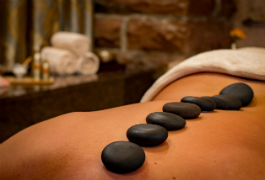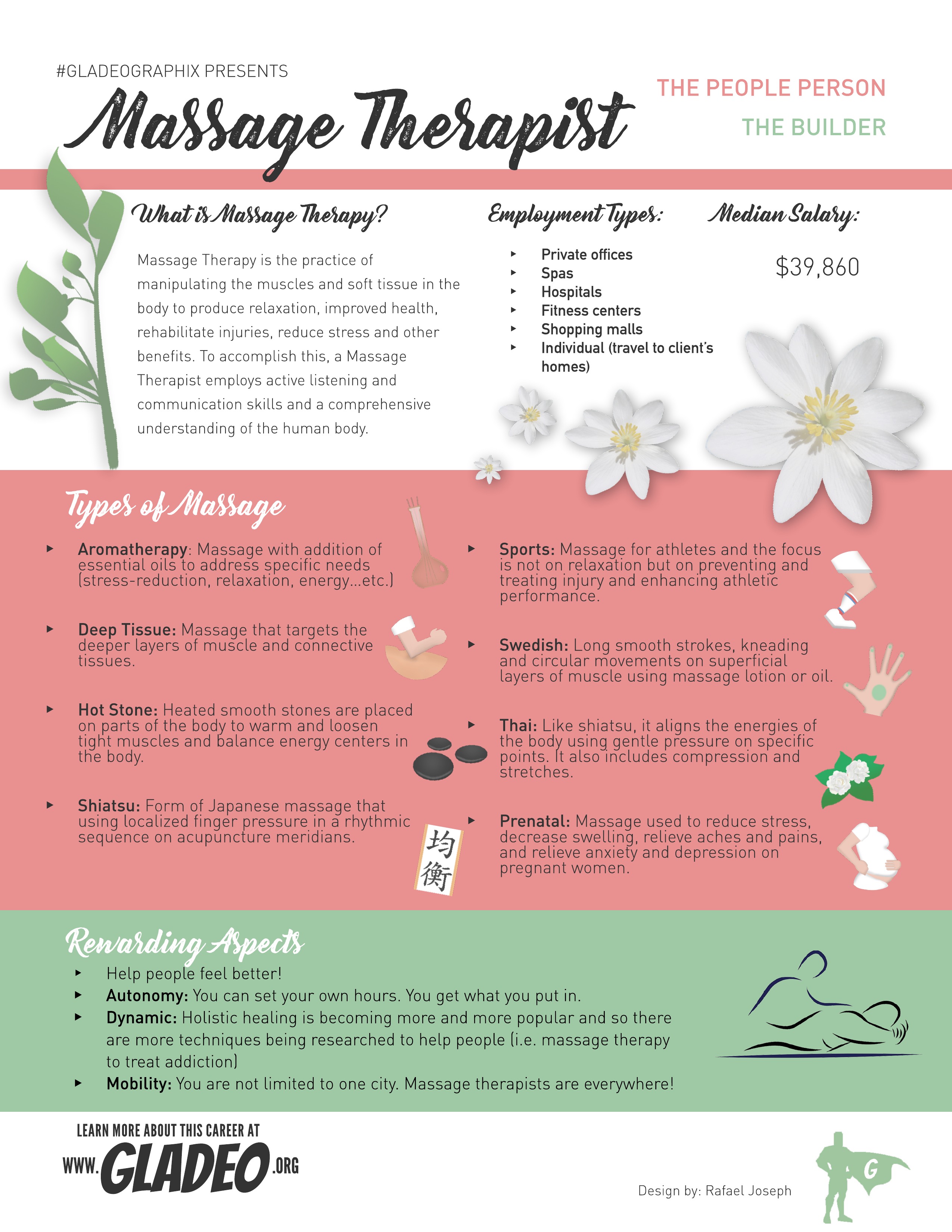Spotlights
Licensed/Certified/Clinical/Medical/Bodywork Massage Therapist
Massage therapists treat clients by manipulating the muscles and soft tissue to produce relaxation, improved health, rehabilitate injuries, and reduce stress and other benefits.
- Help people feel better!
- Autonomy: You can set your own hours. You get what you put in.
- Dynamic: Holistic healing is becoming more and more popular and so there are more techniques being researched to help people (i.e. massage therapy to treat addiction)
- Mobility: You are not limited to one city. Massage therapists are everywhere!
- 25 hours is full-time for massage therapist.
- Flexibility: Massage therapists essentially work for themselves so they set their own schedule and they can work for a hospital for a few hours a week, then a massage clinic for 10 hours, and then have private clients for the rest of the week.
- Empathy
- Compassion
- Networking and marketing skills
- Biology: understanding of the body
- Customer service
- Communication and active listening skills
- Physical strength
Aromatherapy: Massage with addition of essential oils to address specific needs (stress-reduction, relaxation, energy…etc.)
Deep Tissue: Massage that targets the deeper layers of muscle and connective tissues.
Hot Stone: Heated smooth stones are placed on parts of the body to warm and loosen tight muscles and balance energy centers in the body.
Prenatal: Massage used to reduce stress, decrease swelling, relieve aches and pains, and relieve anxiety and depression on pregnant women.
Reflexology: “foot massage” Applies pressure to certain points on the foot that correspond to organs and systems in the body.
Shiatsu: Form of Japanese massage that using localized finger pressure in a rhythmic sequence on acupuncture meridians.
Sports: Massage for athletes and the focus is not on relaxation but on preventing and treating injury and enhancing athletic performance.
Swedish: Long smooth strokes, kneading and circular movements on superficial layers of muscle using massage lotion or oil.
Thai: Like shiatsu, it aligns the energies of the body using gentle pressure on specific points. It also includes compression and stretches.
- Private offices
- Spas
- Hospitals
- Fitness centers
- Shopping malls
- Individual (travel to client’s homes)
- Physically and mentally demanding
- At the beginning of your career, you might need to supplement career with other jobs.
- At the beginning of you career, you might work for a massage franchise and here you will be doing back-to-back massages that can be physically draining.
- Private practice: You have to develop your brand, spend money on marketing and have business acumen.
Holistic field is growing and massage therapy is used in many different special populations like addicts, the elderly, pregnant women, and cancer/MS/IV patients.
- “I was a hands-on learner (learn by doing), instead of books.”
- Sense of compassion, empathy at an early age.
- Massage Therapist education and training requirements vary by state
- In general, they must hold a high school diploma or GED and complete a full- or part-time accredited training program ranging from 500 - 1,000 hours. They don’t need a college degree but do need a certificate or diploma from their training program
- Massage Therapist training includes both classroom study and hands-on practice of massage techniques
- Common courses include anatomy, physiology, kinesiology, and pathology. 38% of Massage Therapists are self-employed so many students study business, too
- There are several different types of massage that therapists can specialize in, such as deep tissue, Swedish, Thai, stone therapy, reflexology, aromatherapy, lymphatic, oncology, trigger point, Shiatsu, sports, and pregnancy and infant massage techniques
- The majority of states require graduated Massage Therapists to obtain a license to work. This usually involves passing either a state-specific exam or the Massage and Bodywork Licensing Examination (MBLEx), managed by the Federation of State Massage Therapy Boards
- Licensure requirements may also include completing a CPR course, showing proof of liability insurance, and passing a background check. Lastly, there’s usually a need to take continuing education classes every two years to maintain licensure
- Practicing Massage Therapists can boost their credentials through board certification from the National Certification Examination for Therapeutic Massage & Bodywork
- Other massage-related certifications include:
- American Health Source -
- Medical Massage Therapy Certification
- Lymphedema Technician Certification
- Holistic Health Care Practitioner Certification
- Scandinavian Mobilization Therapy Certification
- Practical Acupuncture Safety Certification
- American Reflexology Certification Board -
- National Reflexology Certification - Foot Exam
- National Reflexology Certification - Hand Exam
- National Certification Board for Therapeutic Massage and Bodywork - Board Certification in Therapeutic Massage and Bodywork
- National Certification Commission for Acupuncture and Oriental Medicine - Diplomate in Asian Bodywork Therapy
- Zero Balancing Association - Zero Balancing Certification
- American Health Source -
- Classes: anatomy, physiology (study of organs and tissues), kinesiology (study of motion and body mechanics), business management, and ethics.
- Hands-on practice of massage techniques
- Might have internship at hospital or nursing home.
- Try to find a program that will fit your “style”: Do you want to work with athletes? In a hospital? Or more in spa for relaxation?
- 17% with HS Diploma
- 15% with Associate’s
- 22.5% with Bachelor’s
- 4.2% with Master’s
- 3.9% with Doctoral
(*% of employees aged 25 to 44 in the occupation whose highest level of educational attainment is)
- National Holistic Institute
- Myotherapy College of Utah
- National University of Health Sciences
- Miami Dade College
- Cortiva Institute Schools of Massage Therapy
- The Soma Institute, The National School of Clinical Massage Therapy
- Southwest Institutes of Healing Arts
- National Massage Therapy Institute
- Everest College
- Massage Therapists can expect to do hands-on training and practice in various settings. These experiences are invaluable and could lead to full-time jobs after graduation and licensure
- Consider what type of massage you want to specialize in, based on your interests and where you want to work after graduation
- Along with learning the trade, you must hone your people skills and develop a knack for customer service
- Craft your “work persona” and develop your listening and verbal communication skills
- Watch YouTube tutorials, read blogs, and keep up with what’s new and popular
- Make friends with other Massage Therapists. Keep engaged with your network and help each other
- Learn from your fellow students. Ask questions and be willing to explore new methods
- Study additional treatments such as body scrubs, wraps, and hydrotherapy
- During training, you will be interning at different places (hospitals, nursing home). You might be able to get 1 of your jobs through that internship. It will most likely be part-time. You will probably have to work for several places at the beginning.
- Work for a franchise like Massage Envy: Here you will get a lot of experience and exposure so you should develop your style here.
- Apply for massage shops, physical therapists, spas and acupuncturists through online job websites.
- Ask your network and training program staff if they know about any openings
- When doing hands-on practice, give clients unbeatable service and earn strong personal references
- Keep in mind that employers view workers as representatives of their brand and reputation, so learn about the businesses where you apply for jobs
- Employers generally seek a strong mixture of talent, professionalism, and personality
- Massage is a very personal experience for some clients. Personal compatibility is a key factor!
- Many businesses such as spas earn a lot of income through repeat business from loyal guests. During interviews, demonstrate your commitment to customer service and dependability
- Post your resume on employment portals like Indeed and Glassdoor. Check out Craigslist for opportunities, too!
- Read job posts thoroughly and make sure you meet all listed qualifications
- Study Massage Therapist resume templates
- Review sample Massage Therapist interview questions to get an idea of what to expect
- Practice mock interviews so you can present yourself as capable and confident
- Stay up-to-date on trends and terminology so you can impress interviewers
- Open your own Massage Therapist business!
- Brand yourself!: You are essentially self-employed. 1) Self-awareness: You need to know who you are as a massage therapist. What is your intention? What is the experience you are going to be giving? 2) Market and brand outward
- Think of innovative ways to find clientele (if you are self-employed): bachelorette parties, partnership with local sports team/food/services (free massages for marketing?)
- Speak different languages.
- Specialize in more than 1 type of massage and continue to learn new techniques.
- Network but in a genuine way.
- Treat your clients well so they will become your repeat clients.
"As I ventured into private practice as a massage therapist I knew it was going to be important to stand out. I asked myself questions like who am I, who are the types of clients that I want to attract, what is going to be the " look and feel" of my practice; my "brand". I started from there and worked outward. This gave me a solid foundation to build from." Morgan Henry, Anchor Bodyworks
Websites
- American Health Source
- American Massage Therapy Association
- American Reflexology Certification Board
- Associated Bodywork & Massage Professionals
- Commission on Massage Therapy Accreditation
- Federation of State Massage Therapy Boards
- International Association of Healthcare Practitioners
- Massage and Bodywork Licensing Examination
- National Certification Board for Therapeutic Massage & Bodywork
- National Certification Commission for Acupuncture and Oriental Medicine
- Zero Balancing Health Association
Books
- Massage Therapy: Principles and Practice, by Susan G. Salvo EdD LMT BCTMB
- The Complete Guide to Modern Massage: Step-by-Step Massage Basics and Techniques from Around the World, by Ryan Jay Hoyme LMT BCTMB
- The Massage Bible: The Definitive Guide to Soothing Aches and Pains, by Susan Mumford
Newsfeed

Featured Jobs

Online Courses and Tools

Annual Salary Expectations
New workers start around $34K. Median pay is $57K per year. Highly experienced workers can earn around $77K.






